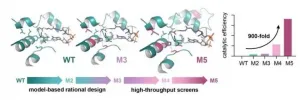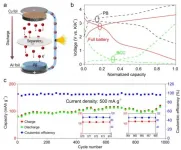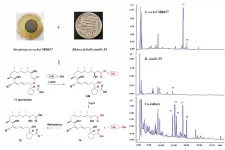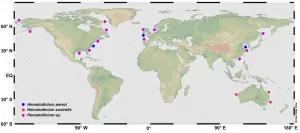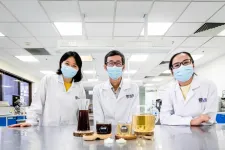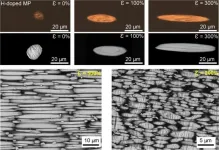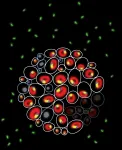(Press-News.org) Photorespiration is a highly energy consuming process in plants that leads to the release of previously fixed CO2. Thus, engineering this metabolic process is a key approach for improvement of crop yield and for meeting the challenge of ever-rising CO2 levels in the atmosphere. Researchers led by Tobias Erb from the Max Planck Institute for Terrestrial Microbiology in Marburg, Germany, have now succeeded in engineering the TaCo pathway, a synthetic photorespiratory bypass. This new-to-nature metabolic connection opens up new possibilities of CO2 fixation and the production of value-added compounds.
All life is dependent on the fixation of CO2 through plants. However, enzymatic efficiency of natural photosynthesis is limited, setting a boundary on agricultural productivity and CO2 fixation. Photorespiration is a detoxification process in plants that recycles a toxic by-product of photosynthesis, 2-phosphoglycolate. Photorespiration is highly energy consuming and leads to the release of previously fixed CO2, thus further curbing the photosynthetic balance.
Researchers led by Tobias Erb from the Max Planck Institute for terrestrial Microbiology have developed a synthetic photorespiratory bypass that represents an alternative to natural photorespiration. In collaboration with the group of Arren Bar-Even (Max Planck Institute of Molecular Plant Physiology, Potsdam-Golm), and within the EU-funded project Future Agriculture, the team has designed the so-called tartronyl-CoA (TaCo) pathway that is much shorter than natural photorespiration and requires only 5 instead of 11 enzymes. The perhaps greatest benefit of the TaCo pathway is that it fixes CO2 instead of releasing it, as it happens in natural photorespiration. As a result, the TaCo pathway is more energy efficient than any other proposed photorespiratory bypass to date.
Building the TaCo pathway was a scientific journey that has led the researchers from computational model through enzymatic engineering, microfluidic high-throughut screening, cryo-EM-technology towards the successful in vitro implementation of a new-to-nature metabolic connection that opens up new possibilities for CO2 fixation and the production of value-added compounds. "The main challenge in realizing the TaCo pathway was to find all the required enzymes," Marieke Scheffen, Postdoctoral researcher in Tobias Erb's group and lead author of the study, recalls. "It meant that we had to look for enzymes that perform similar reactions and then "teach" them to perform the desired reaction."
More efficient enzymes
For the TaCo pathway, initially a handful of enzymes was found that were able to catalyze the required reactions. However, they showed low catalytic efficiencies, meaning that they were quite slow compared to naturally occurring enzymes. The researchers aimed to boost especially the performance of the key enzyme of the TaCo pathway, glycolyl-CoA carboxylase (GCC), the catalyst that makes photorespiration carbon positive.
As a groundwork for creating a synthetic glycolyl-CoA carboxylase (GCC) the researchers developed a molecular model of the enzyme. Different variants of the enzyme were created based on a naturally occurring propionyl-CoA carboxylase, which is usually involved in fatty acid metabolism, as a scaffold by exchanging amino acid residues. This rational design strategy led to a 50-fold improvement of the enzyme's catalytic efficiency with glycolyl-CoA.
In order to push the enzyme's performance even further, the researchers teamed up with the group of Jean-Christophe Baret from the French National Centre for Scientific Research (CNRS, CRPP) Bordeaux, France, with whom they developed an ultrahigh-throughput microfluidic screen and screened thousands of synthetic variants. Within two rounds of subsequent microplate screenings, an enzyme variant was discovered that showed an even almost 900-fold increased catalytic efficiency with glycolyl-CoA. "With this catalytic efficiency, GCC is in the range of naturally occurring biotin-dependent carboxylases. This means we were able to engineer an enzyme from almost no activity towards glycolyl-CoA to very high activity, which is comparable to naturally evolved enzymes," Marieke Scheffen explains.
High-resolution electron microscopy
Solving the molecular structure of this newly developed catalyst was achieved in yet another collaboration, with Jan and Sandra Schuller from the Max Planck Institute of Biochemistry, Martinsried (now SYNMIKRO in Marburg). The researchers applied cutting-edge cryogenic electron microscopy (cryo-EM) at an atomic resolution of 1.96 Å, thus pushing the limits of cryo-EM.
Finally, the synthetic GCC enzyme proved functional in in vitro experiments in combination with the two other enzymes of the TaCo pathway, thus forming an applicable carbon fixation pathway. "The TaCo pathway is not only a promising alternative for photorespiration", says Group Leader Tobias Erb. "We could also show that it can be interfaced with other synthetic CO2 fixation cycles, like the CETCH cycle. Now we will be able to efficiently link synthetic CO2 fixation directly to central metabolism."
This opens up a range of scientific possibilities, for example towards the recycling of polyethylene terephthalate (PET). The TaCo pathway could be used to convert ethylene glycol (a monomer of PET) directly into glycerate, making it usable for the production of biomass or value-added compounds. The next step will be to advance the in vivo implementation, in order to harness the full potential of the newly developed pathway.
INFORMATION:
Original publication
Scheffen, M.; Marchal, D.G.; Beneyton, T.; Schuller, S.K.; Klose, M.; Diehl, C.; Lehmann, J.; Pfister, P.; Carrillo, M.; He, H.; Aslan, S.; Cortina, N.S.; Claus, P.; Bollschweiler, D.; Baret, J.-C.; Schuller, J.M.; Zarzycki,J.; Bar-Even, A.; Erb, T.J.
A new-to-nature carboxylation module to improve natural and synthetic CO2 fixation
Nature Catalysis 1 (2021)
Published 04 January 2021
With the rapid development of smart portable electronics and electric vehicles, the consumption of lithium resource will increase dramatically and the cost of lithium-ion batteries (LIBs) may increase significantly in the future. In addition, the shortage (0.0017 wt% in the earth's crust) and uneven crustal distribution of lithium also limit its further development and application. As potassium (2.7 wt% in the earth's crust) have properties similar to lithium and abundant reserves. Therefore, as an alternative to LIBs, potassium ion batteries (PIBs) have become the focus of research. Potassium (2.92 V vs. ...
Scientists from the Max Planck Institute of Psychiatry, led by Nikolaos Koutsouleris, combined psychiatric assessments with machine-learning models that analyse clinical and biological data. Although psychiatrists make very accurate predictions about positive disease outcomes, they might underestimate the frequency of adverse cases that lead to relapses. The algorithmic pattern recognition helps physicians to better predict the course of disease.
The results of the study show that it is the combination of artificial and human intelligence that optimizes the prediction ...
The spiky structure that erupts from the smooth surface of a ferrofluid when a magnet is brought close can be predicted more accurately than previously thought. KAUST researchers have shown that computational algorithms can calculate the ferrofluid's bristling response to a magnet by simulating only the liquid's surface layer.
Ferrofluids are liquid suspensions of iron-based particles that behave like a regular fluid, but once a magnet is present, the ferrofluid rapidly shape-shifts to form spikes that align with the magnetic field. Originally developed by NASA, ferrofluids have numerous uses ranging from advanced electronics to nanomedicine and have the potential for even broader use, if their magnetic responses could be predicted more accurately.
Dominik Michels and ...
Co-culture: stimulate the metabolic potential and explore the molecular diversity of natural products from microorganisms
Announcing a new publication for Marine Life Science & Technology journal. In this review article the authors Xiao-Yue Peng, Jin-Tao Wu, Chang?Lun Shao, Zhi-Yong Li, Min Chen and Chang-Yun Wang from the Ocean University of China, Qingdao, China, Yangzhou University, Yangzhou, China, Qingdao National Laboratory for Marine Science and Technology, Qingdao, China and Shanghai Jiao Tong University, Shanghai, China consider the metabolic potential and molecular diversity of natural products from microorganisms.
Microbial secondary metabolites have long ...
Announcing a new publication for Marine Life Science & Technology journal. In this review article the authors Caiwen Li, Meng Li and Qian Huang from Institute of Oceanology, Chinese Academy of Sciences, Qingdao, China consider the impact of the parasitic dinoflagellate Hematodinium on aquaculture of marine crustaceans in China.
Hematodinium is a type of parasitic dinoflagellate that infects marine crustaceans globally. The parasite lives mainly in the hemolymph or hemocoels of affected hosts, and results in mortalities due to malfunction or loss of functions of major organs.
In recent years, the parasite has developed into an emerging epidemic pathogen not only affecting wild populations of economically valuable marine crustaceans ...
Good news for those who need a cuppa to start the day. Researchers from the National University of Singapore (NUS) have created new probiotic coffee and tea drinks that are packed with gut-friendly live probiotics.
Supervised by Associate Professor Liu Shao Quan from the Department of Food Science and Technology at the NUS Faculty of Science, the two doctoral students who worked on these two new beverages assert that their drinks have a great taste, and can be stored chilled or at room temperature for more than 14 weeks without compromising on their probiotic viability.
Traditional probiotic carriers like yoghurts and cultured milks are dairy-based products. The rise in veganism, along with common health issues like lactose intolerance, high ...
Today's electronic devices strive for new form factors - to make them foldable, stretchable, and deformable. To produce such devices that are highly stretchable or deformable, it is necessary to develop electrodes and circuit lines whose electrical properties can withstand harsh deformation or mechanical damage. To this, POSTECH-Yonsei University joint research team has recently developed liquid metal ink to accelerate printed electronic devices that can be changed into any shape.
Professor Unyong Jeong and Dr. Selvaraj Veerapandian of POSTECH's Department of Materials Science and Engineering, with Professor Aloysius Soon and Dr. Woosun Jang of Yonsei University's Department of Materials Science and Engineering, have developed liquid metal microparticles ...
NIH-supported pilot study found team-based approach may improve buprenorphine care.
WHAT:
A collaborative approach to treating opioid use disorder that relies heavily on community pharmacists is feasible and may increase adherence and participant satisfaction, according to a pilot study published today in Addiction. The study was supported by the National Institute on Drug Abuse (NIDA), part of the National Institutes of Health, through the NIDA Center for the Clinical Trials Network.
Most people with opioid use disorder who would benefit from medication do not receive it. Buprenorphine is a safe and effective ...
DALLAS - Jan. 11, 2021 - A set of biomarkers not traditionally associated with cell fate can accurately predict how genetically identical cells behave differently under stress, according to a UT Southwestern study. The findings, published by Cell Reports as a Dec. 1 cover story, could eventually lead to more predictable responses to pharmaceutical treatments.
Groups of the same types of cells exposed to the same stimuli often display different responses. Some of these responses have been linked to slight differences in genetics between individual cells. However, even genetically identical cells can diverge in ...
As the planet continues to warm, the twin challenges of diminishing water supply and growing energy demand are intensifying. But because water and energy are inextricably linked, as we try to adapt to one challenge - say, by getting more water via desalination or water recycling - we may be worsening the other challenge by choosing energy-intensive processes.
So, in adapting to the consequences of climate change, how can we be sure that we aren't making problems worse?
Now, researchers at the Department of Energy's Lawrence Berkeley National Laboratory (Berkeley Lab), UC Berkeley, and UC Santa Barbara have developed a science-based analytic framework to evaluate such complex connections between water and energy, and options for adaptations in response to an evolving ...
